


Dhatryadi Ghrita: Medicine for Complete Biological Care for Women
Rashmi Saxena Pal1*, Amrita Mishra2
1Assistant Professor, Pharmacy Department, PSIT, Kanpur, India.
2Assistant Professor, SPS, IFTM University, Moradabad, India.
ABSTRACT
Background: Health care of women in nowadays’ life, which is full of stress and anxiety, and the present lifestyle that has become a topic of major concern, and is ignored most of the time, are the reasons why females are suffering from anemia, blood-related disorders, leucorrhoea, and infertility. Apart from this, the lack of proper care in pregnancy and post-pregnancy is also a major issue. There is a need for complete care offering natural formulation, which can aid women in every phase of life. Objective: The objective of this review is to extract the healing potential present in natural and herbal ingredients for today’s women. There are many aspects of concern for care in normal daily routine, in pregnancy, lactation period, and the post-menopausal state as well. Material and Methods: Complete research was performed over the natural constituents of Dhatryadi Ghrita to establish the therapeutic and pharmacological potential of the Ghrita. Result: There are many natural resources present in nature and unexplored potential, as medicines are tremendous. But still, the awareness is not up to the mark. Dhatryadi Ghrita, which is a perfect blend of such potent herbs, acts as nutritive and enhances milk production. Also, it deals with iron requirements and improves fertility in females. Conclusion: Ghrita is a rich blend of herbs, which are rich in phytoconstituents. The need for the current scenario is to prefer a natural, herbal-based formulation as Dhatryadi Ghrita as per medical supervision to overcome the various problems of females.
Keywords: Dhatryadi, Ghrita, Herbs, Nutritive, Women, Health
Dhatryadi Ghrita, medicated ghee or clarified butter, is a popular classic Ayurveda formulation, mainly used to treat disorders related to pitta and Raktapitta. Dhatryadi Ghrita is rich in natural ingredients as Ghee, obtained from the milk of Cow, Emblica Officinalis, Shatavari or Asparagus racemosus, Liquorice, or Glycyrrhiza glabra, Sugarcane or Saccharum officinarum, Sveta Candana or Santalum album, Cow milk, Kusmanda, Vidari, Raisins or Draksha, and Crystal sugar. The uses of Dhatryadi Ghrita and its ingredients have been well defined in ancient Ayurveda texts like Charak and Sushrata Samhita etc. (Pal and Mishra, 2017). These lipid-based, polyherbal formulations have the unique property to surpass the blood-brain barrier and exhibit many beneficial effects on brain tissue. Dhatryadi Ghrita is a medicated ghee, derived from herbs, where ghee acts as the base and is recommended for the treatment of various CNS related aspects. Its major constituent is Dhatri or Emblica Officinalis (Pal and Mishra, 2018). Herbal medicine is used to cure various ailments and has been well proven with the help of various trials as discussed in this article. Their use promotes modern therapeutics having roots in the old ages of Ayurveda (Sumanth and Ugendra, 2013). Nowadays, life is full of stress and anxiety. The present lifestyle has become a topic of major concern, which is ignored most of the time, as the reason why females are suffering from anemia, blood-related disorders, leucorrhoea, and infertility. Apart from this, the lack of proper care in pregnancy and post-pregnancy is also a major issue (Thum and Anker, 2007). Iron-deficiency anemia signifies that the body does not have sufficient iron. Iron is needed by the body to supply oxygen through the blood to all parts of the body. Iron-deficiency anemia occurs majorly in women than men and is more common during pregnancy (Shill et al., 2014). Hemoglobin levels below 11 gm /dL at any point of pregnancy are considered abnormal. Once anemia is diagnosed, the reasons for iron deficiency should be taken care of (Burke et al., 2014). Iron requirements are more than average iron requirements during menstruation. The iron lost in menstrual blood is important for consideration for women of reproductive age (Allen et al., 2006; Brabin et al., 2001). The biomedical aspects of Leucorrhea are related to infections of the reproductive tract, local infections, as well as sexual transmission (Wasserheit et al., 1989; Snowden and Christian, 1983; Bang et al., 1989). Infertility, due to endometriosis, disorders related to ovulation, tubal infertility, and unexplained infertility are also major concerns (European Society for Human Reproduction and Embryology, 1996; Cahill and Wardle, 2002; Liu et al., 2005). Maternal malnutrition affects the fetus. The infants, thereby face increased risks of perinatal death or damage, along with gross neurologic abnormalities (Singer et al., 1968; Moghissi, 1978; Pitkin, 1976). Caring for a mother is essential for her overall healing, strength regaining, vitality, muscle tone, and overall health and well-being (Ekor, 2014; Coelius et al., 2012; Konan et al., 2014). Greater awareness and decrease of probability for various related diseases in women are much-needed aspects in the present time. While medicines for prevention are being used more frequently in women, greater use of effective measures and less use of potentially harmful ones are warranted. During these years, women are at increased risk of osteoporosis and cardiovascular diseases as well (Dennerstein et al., 2000; Obermeyer, 2000; MacLennan et al., 2002; Basturk et al., 2016; Karakus et al., 2016). There are various areas of concern as care in normal daily routine, in pregnancy, lactation period, and the post-menopausal state as well. There is a need for a natural option that can provide complete health care in all the phases of life for today’s women (Sundus, et al., 2018; Shakeri, et al., 2018; Darkhor, et al., 2018; Mathialagan, et al., 2018). This article deals with the various benefits of Dhatryadi Ghrita fulfilling all the above aspects dealing with the life of women.
Complete research was performed over the natural constituents of Dhatryadi Ghrita to establish the therapeutic and pharmacological potential of the Ghrita, using keywords as Dhatryadi, ghrita, herbs, nutritive, women, and health.
Table 1: Ingredients of Dhatryadi Ghrita
|
Sr. No |
Ingredient |
Botanical Name |
Useful Part |
Main Constituent |
|
1. |
Amla |
Emblica Officinalis |
Fresh Fruits |
Tannins |
|
2. |
Vidari |
Pueraria Tuberosa |
Tuberous Roots |
Gluconic Acid |
|
3. |
Iksu |
Saccharum Officinarum |
Dried Stem |
Sucrose |
|
4. |
Shatavari |
Asparagus Racemosus |
Tuberous Roots |
Shatavarin |
|
5. |
Kusmanda |
Benincasa Hispida |
Dried Fruits |
Fatty Oils |
|
6. |
Draksha |
Vitis Vinifera |
Dried Fruits |
Malic Acid |
|
7. |
Yasti |
Glycyrrhiza Glabra |
Stolon & Root |
Glycyrrhizin |
|
8. |
Sveta Chandana |
Santalum Album |
Heart Wood |
Santalol |
|
9. |
Go Ghrita |
Butyrum Deparatum |
- |
Unsaturated Fats |
Table 1 indicates the chemical composition of Ghrita, showing the perfect blend of all the natural ingredients, which are: free of any side effects, non-habit forming, cheaper, easily available, and having a larger shelf life. The various issues of major concern, which are treated and taken care of by Dhatryadi Ghrita are described as following in Figure 1.
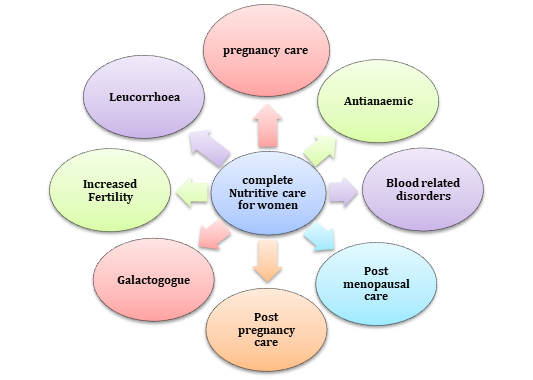
Figure 1: Complete Biological Care for Women by Dhatryadi Ghrita
Anemia: Anemia occurs in women more as compared to men. WHO states that its prevalence among women is 21-80% throughout the world. It is a serious concern that negatively impacts the overall health of women and their workability, mainly in their reproductive years, and leads to increased infant and maternal mortality (Basturk et al., 2016; Karakus et al., 2016; WHO, 2008). Iron-deficiency anemia occurs when intake of iron, by diet, is less or when the iron is not sufficiently absorbed, when bodily requirements are more, as in cases of excessive blood loss (Massawe et al., 2002; Erdem et al., 20009; Bhandari et al., 2016; Gereklioglu et al., 2016). So for anemia, iron pills are given as a supplement, but iron supplements can cause diarrhea, constipation, stomach upset, and are not readily absorbed as the iron from food. If the Amalaki (Emblica Officinalis) as in Figure 2, in the form of Churna is added to the iron tablet it enhances the action of iron by increasing its absorption and lowering the adverse effects of the iron tablet (Nadkarni and Nadkarni, 2007; Ambika Dutta Shastri, 2002). Amla with pumpkin leaves extract, when administered to Anemics, there was a significant difference noticed in the pre-test and post-test level of hemoglobin and iron. In the experimental group, there was a rise in mean values for hemoglobin from 9.942 to 10.99 and iron from 77.6 to 99.58 (Resmi et al., 2017). Raisin seeds are rich in iron content. Also, raisins are much concerted as compared to grapes. Raisins contain 15% water while fresh grapes possess 80% water. They are healthy food being rich in iron and dietary fiber. In iron deficiency anemia, observed in medical students of South India, after 8 weeks of daily intake of jaggery and raisins, it was noted that there was a significant rise in the mean hemoglobin level to 11.79 ± 1.07 (P < 0.0001) and also a substantial rise in the mean red blood cell count to 4.22 ± 0.30 (P < 0.0001). The Hemoglobin increased to 11.79 and the mean RBC count increased to 4.22 (Sakthibalan et al., 2018; Karadeniz et al., 2000; Williamson and Carughi, 2010). Raisins are consumed throughout the world because of their exclusive nutrient profile with multiple benefits. Raisins impart minerals and dietary fiber including fructooligosaccharides. One snack serving of raisins provides 129 kcal, 1.6 g dietary fiber, and 0.8 mg iron (Anderson and Waters, 2013; Kanellos et al., 2014). Dhatryadi Ghrita consists of fresh juice obtained from fruits of amla and crushed raisins as well, which are very good to fulfill the iron requirements.
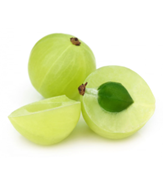
Figure 2: Amla Fruit
Blood-related Disorders: It is majorly used as medicine and also in leucorrhoea, menorrhagia, and metrorrhagia. The fruit of Kusmanda as shown in Figure 3, is rich in flavonoids and terpenoids, therefore it is extremely useful in the treatment of bleeding disorders. It contains pentacyclic triterpenoids and bryonolic acid, triterpenoid present in the Cucurbitaceae family plays a major role (Benincasa hispida-brihatphala A –review, 2011; Pal et al., 2018). The ancient text says that powdered sugar mixed with powder of Candana used orally is useful in raktapitta or blood disorders. In case of bleeding, the oral use of the mixture of dried ginger and Candana is recommended. Petroleum ether and ethanol derivatives of Santalum album on screening and investigation in detail by using analytical methods as chromatographic and spectroscopic techniques disclosed that petroleum ether extract has MIC value for B. subtilis, P. aeruginosa, E. coli, and C. Albicans were 78.125 µg/ml, 19.331 µg/ml, 625 µg/ml and 39.062 µg/ml, respectively, while MBC was 39.062 µg/ml, 4.882 µg/ml, 312.5 µg/ml and 9.765 µg/ml, respectively. Petroleum ether extract showed MIC and MBC values for S. aureus were similar to 156.25µg/ml. So, the extract in petroleum ether showed significant antimicrobial activity (Gautam et al., 2017; Gupta et al., 1973; Westrom, 1987). The phytoconstituents of Shatavari make it beneficial in the treatment of dysmenorrhea, premenstrual syndrome, irregular bleeding, etc. It is rich in saponins which block the oxytocic activity of uterine muscles, confirming its utility in dysmenorrhea (Jetmalani et al., 2004; Mitra et al., 1998; Dhaliwal et al., 2003). Dhatryadi Ghrita contains the juice of fresh fruits of Kushmanda and roots of Shatavari to ease the disorders related to blood.
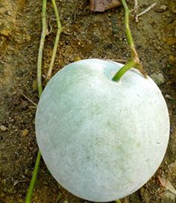
Figure 3: Fruit of Kushmanda
Leucorrhoea: This is mainly the white color discharge from the female genital organs. It is an abnormal condition of women, in which the reproductive organs are affected (Eschenbach et al., 1975; Neves and Bahia, 2006; Osei and Critchley, 2005). Leucorrhoea facilitates faster healing in leucorrhea along with herbal tea such as green tea formed in combination with leaves of sage or blackberry (Hakakka, 2002; Tabassum et al., 2014). Liquorice roots as shown in Figure 4 are helpful in the treatment for the same. Due to the presence of flavonoid glycosides, it helps to fight the symptoms of leucorrhoea. Side effects of Liquorice are headache, high blood pressure, fluid retention, etc. (Sheth, 2005; Khare, 2004). Shatavari herb is used in disorders related to the female reproductive system. It is used as part of the formulas to treat disorders affecting women’s health (Sharma and Dash, 2003; Atreya, 1999; Srikantha, 1997; Thomson, 2002; Gopumadhavan et al., 2002). Dhatyradi Ghrita has powdered roots of Liquorice added to it.
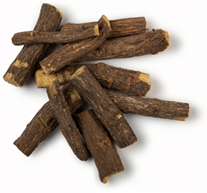
Figure 4: Liquorice Roots
Increased Fertility: Asparagus or Shatavari in Figure 5, containing preparations stimulates the hemopoietic function and increases the weight of accessory sex glands. The plant is also beneficial in female infertility, as it increases folliculogenesis and ovulation, prepares the womb for conceiving, and prevents abortions. The observed activity was due to Shatavarin-I. In vivo effect of shatavarin IV i.e., saponin A4 on the muscles of the uterus is the same as that of estrogen. The polycyclic alkaloid asparagamine A has been reported to impart an anti-oxytocic action and anti-abortifacient effect (Garg, 1971; Dev, 1999; Gaitonde and Jetmalani, 1969; Goyal and Kulkarni, 2002; Chauhan et al., 2013; Gupta et al., 2005). Vidarikand, a perennial herb is known for the properties as promotes the production of sperm or semen. In-vitro and in-vivo studies have shown the spermatogenic and aphrodisiac potential of tubers. It has been used in various ayurvedic formulations in the form of restorative tonic, immune booster and has been used for the treatment of fertility disorders, menopausal syndrome, and spermatorrhoea. Many bioactive phytochemicals, main isoflavonoids as puerarin, genistein, daidzein have been isolated and identified in the tuberous roots of the plant (Kelly et al., 2010; Kanellos et al., 2014; Nuts & Dried Fruits Global Statistical Review 2015 / 2016, p 66, 2017).
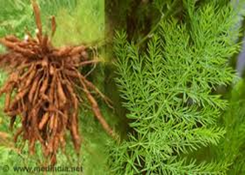
Figure 5: Shatavari
Care in Pregnancy: All the basic requirements such as Iron, other nutrients, and minerals are fulfilled with this formulation.
Nutritive: Raisins contain 34 grams of carbohydrates, 26 grams of sugar for providing quick energy. Its consumption every day helps to fulfill the daily requirement for iron. Iron in the body is carried along with oxygen in red blood cells. Potassium is vital for the heart as it governs the heartbeat and also lowers blood pressure by limiting the effect of sodium. Raisins contain healthy dietary fibers, carbohydrates with a low glycemic index, and minerals like copper and iron, with minor fat content (Bays et al., 2012; Chiou et al., 2014; Jain and Khurdiya, 2004; Zhang et al., 2003).
Antianaemic: Compounds isolated from Emblica, which makes it useful for anemia are gallic acid, ellagic acid, galloyl-D-glucose, chebulinic acid, quercetin, ethylgallic acid, and isostrictiniin. It is the richest source of Vitamin C and tannins (Rehman et al., 2007; El-Desouky et al., 2008; Joglekar et al., 1967; Sholapurkar, 1968).
Post-pregnancy Care: Post-partum is a significant time for the mother, newly born, and the entire family. Many physiological, psychological changes occur at this time. In addition to rest, all mothers need to maintain a healthy diet to promote healing and recovery.
Galactagogue:
The crude alcoholic extract of the roots of Shatavari enhances the weight of mammary glands in post-partum and estrogen-primed rats and the uterine weight in the estrogen-primed group, as per the study’s results obtained. Oral administration of the roots of Shatavari increased the milk yield in many animals. It is used as a galactagogue. It has been found that its roots and its extracts can improve lactational deficiency in lactating mothers. The randomized double-blind clinical trial evaluated its galactagogue effect in 60 lactating mothers by keeping a check on the prolactin hormone level during a study. The mean prolactin hormone level showed a percentage elevation of 32.87 ± 6.48 through the practical tenure in the case of the research group, while the control group showed a percentage enhancement of only 9.56 ± 4.57 in the mean prolactin hormone level. The increase in the mean prolactin hormone level of the subjects in the research group was three times more than that of the subjects in the control group during the study period. In a study, among rats, an alcohol extract of Shatavari increased the production of milk with increased growth of the mammary glands, alveolar tissues, and acini. Chemical evaluation of Shatavari roots showed the presence of saponins and steroidal saponins and the estrogenic activity results from the hormone-like actions of these steroidal saponins (Gupta and Shaw, 2011; Narendranath et al., 1986; Arda Isik et al., 2015; Arda Isik et al., 2018; Sabins et al., 1968; Sharma and Bhatnagar, 2011; Gupta and Shaw, 2011; Misra and Renu, 2000).
Postmenopausal Care: Menopause is an important event in women’s lives as they transit from the reproductive to the non-reproductive stage. Few years before and after this change, most women face problems like palpitations, insomnia, anxiety, etc. Therefore, women are opting for a safe alternative as compared to synthetic steroidal hormones. Shatavari present in this formulation is rich in phytoestrogens for reducing adverse menopausal symptoms. Various formulas containing it have shown their effectiveness in alleviating the symptoms in and postmenopausal period. The preparations based on it are recommended in cases of abortions. Twenty-seven women in the age group of 35 to 56 years with symptoms of menopause participated in the trial. All the 27 women were administered Menosan containing licorice and Shatavari at a dose of 2 tablets daily and reviewed monthly for 3 months and at the end of 6 months to determine the effect of the drug and also the side effects if any. Eventually, it was found that the mean S. FSH and S. LH did not show significant changes (Lobo et al., 1984; Molteni et al., 1995; Mills and Bone, 2001; Singh and Kala, 2002; Gopumadhavan et al., 2002; Goyal and Kulkarni, 2002).
A vast potential of healing is present in nature. Today there is a demand to discover the unexplored potential of them since they are very advantageous as compared to the chemical-based substitutes when used for the issues based on the complications faced by the new mom post-pregnancy. They are slow in the onset of action but deal gradually with the root cause of the ailments to reduce the relapse of the disease to minimal. They deal with all the complications and issues occurring post-pregnancy. They treat the uterus which undergoes so many changes, provide nutrition, and increase the production of milk, they also restore the tone and strength of the abdominal walls. Dhatryadi Ghrita fulfills provide complete health care in all the phases of life for women.
A compilation of different herbs or supplements works better than just one. These herbs are bestowed with the phytoconstituents, that heals the whole system. They help to restore the loss of energy, nutrients, and stamina. They are free from chemicals and their derivatives in one or either form, either used as such or in the form of excipients. They are non-habit forming, non-toxic. There are negligible chances of relapse. The need of the present time is to take patiently these as the source of medicines regularly under medical supervision. This study concludes that Dhatryadi Ghrita has great pharmacological and therapeutic capacity. The use of these ingredients of Dhatryadi Ghrita is justified from the research findings of various experimental studies. Dhatryadi Ghrita and its ingredients are proved to treat anemia, female infertility, blood disorders, and many other therapeutic uses.
Availability of Data and Materials:
Literature was reviewed narratively to pertain the information about herbs that deals with overcoming the various problems that arise in women. The search was done on Google scholar, MEDSCAPE, BMC, Science Direct, MEDLINE database, SCOPEMED, and other relevant databases, using keywords as Dhatryadi, ghrita, herbs, nutritive, women, health, dealing mainly with the reviews, researches, findings of seminars, symposiums, conferences over the topic of herbal women care.
Consent for publication
Not applicable.
Conflict of interest
The authors declare no conflict of interest, financial or otherwise.
Declared none.
REFERENCES
